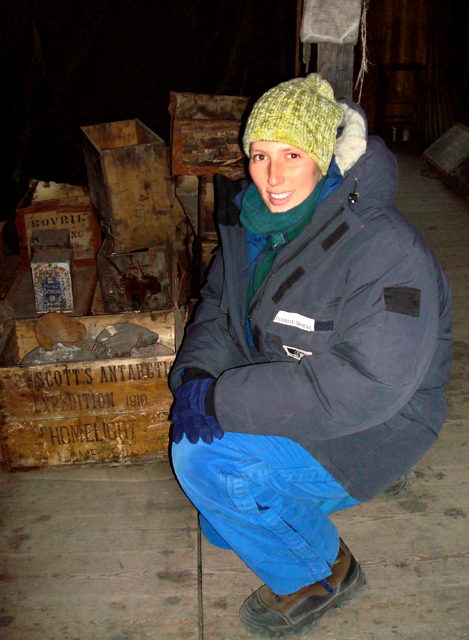Saving historic sitesConservator spends winter in Antarctica to help restore artifacts of early explorersPosted February 6, 2009
Climbing a mountain, rappelling down a crevasse, and preserving artifacts from two of the most famous explorers in human history, is not how I would typically describe my summer, but this is exactly what I did during my seven-month journey in Antarctica. Contracted by the Antarctic Heritage Trust Before my adventure in Antarctica began, I was a conservator in the United States who specialized in materials from waterlogged archaeological sites. I took a seven-month sabbatical from my position at The Mariners’ Museum Beginning in February 2008, I joined three other conservators who also specialized in either paper or objects: Therese Charbonneau (Canada), Carla Pike (Canada) and Lizzie Meek (New Zealand). After a few days of Antarctic field training where we learned how to build snow shelters, erect tents, and generally move around in 25 pounds of additional clothing, we began setting up a laboratory to work on the artifacts. We shared Scott Base, maintained and run by Antarctica New Zealand As an objects conservator, I am used to uncovering details and preserving materials from a variety of burial environments, but I did not realize the personal and telling story that the artifacts from the early explorers would reveal. The Trust is responsible for four expedition bases, not only constructed by Scott and Shackleton, but also by a lesser-known explorer, Carsten Borchgrevink. Each of the bases is listed on the World Monuments Fund The summer teams of cultural heritage experts, who are on-site from October to February each Antarctic summer, use the 24-hour daylight and warmer temperatures to live and work at the historic huts. Their main goal is to secure the huts from the elements through carpentry work, and safely document and package the artifacts at the huts for transportation back to Scott Base for conservation work. Due to the several months of 24-hour darkness and severe weather experienced in the Antarctic winters, a second winter team works to conserve the individual objects in a more controlled environment at Scott Base. The conservation of the materials from the huts and the wooden structures themselves tell perhaps the most important story of the human race, one of survival and exploration. The bases do not belong to one nation, but rather represent the unity of several cultures for one common goal. Antarctica is the last continent on Earth where the first human dwellings survive. Work to save the first of the huts, Sir Ernest Shackleton’s base (associated with his 1907 expedition) is all but complete and the Trust is now focused on saving the base associated with Scott’s 1910 expedition and the race for the Pole. The Trust has a long-term international heritage conservation project and fund-raising campaign under way to save these sites. The goal of the Trust is to conserve the huts, surrounding structures, and objects inside for future generations to appreciate, but you can experience them right now. The conservators on the Ice, through the London Museum of Natural History During our seven months at Scott Base, we did our own exploring of the nearby ice shelf, crevasses and mountains. One of my favorite trips was to Mount Nipha, a small mountain located on White Island, about a five-hour drive from Scott Base. After a vigorous climb, we looked out over the tops of the clouds to Mount Erebus, the southernmost active volcano in the world. Another favorite trip was to a nearby crevasse, where we learned how to descend using ropes and harnesses. Once you were inside, the breathtaking silence made you feel as if you were entering a sacred place that could only be appreciated individually. My life was forever changed by my experience in Antarctica, and while I realize the early explorers endured more difficult mental and physical conditions, I can’t help but feel that they too were affected by the continent’s beauty, even in the most trying conditions. I learned to live with what food and resources were available and nothing more. I learned more about myself and my place in this world as a human being, and while I challenged myself to do things that I would have never dreamed of, I loved every minute. Even the coldest ones. |



For USAP Participants |
For The Public |
For Researchers and EducatorsContact UsNational Science FoundationOffice of Polar Programs Geosciences Directorate 2415 Eisenhower Avenue, Suite W7100 Alexandria, VA 22314 Sign up for the NSF Office of Polar Programs newsletter and events. Feedback Form |



